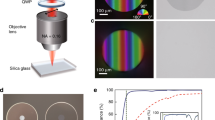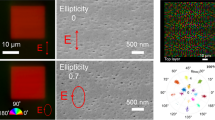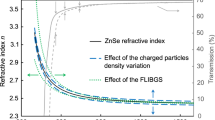Abstract
Photorefractive materials1 exhibit a spatial modulation of the refractive index due to redistribution of photogenerated charges in an optically nonlinear medium. As such, they have the ability to manipulate light and are potentially important for optical applications1 including image processing, optical storage, programmable optical interconnects and simulation of neural networks. Photorefractive materials are generally crystals, polymers and glasses with electro-optic or birefringent properties and non-centrosymmetric structure2. Here we report the photorefractive effect in both non-centrosymmetric and centrosymmetric azo-dye-doped silica glasses, in which refractive index gratings that are spatially phase-shifted with respect to the incident light intensity pattern are observed. The effect results from a non-local response of the material to optical illumination, and enables the transfer of energy between two interfering light beams (asymmetric two-beam coupling). Although the writing time for the present grating is relatively slow, we have achieved a two-beam coupling optical gain of 188 cm-1 in the centrosymmetric glasses, and a gain of 444 cm-1 in the non-centrosymmetric structures. The latter are fabricated using a corona discharge process3 to induce a permanent arrangement of azo-dye chromophores.
This is a preview of subscription content, access via your institution
Access options
Subscribe to this journal
Receive 51 print issues and online access
$199.00 per year
only $3.90 per issue
Buy this article
- Purchase on Springer Link
- Instant access to full article PDF
Prices may be subject to local taxes which are calculated during checkout



Similar content being viewed by others
References
Petrov, M. P., Stepanov, S. I. & Khomenko, A. V. Photorefractive Crystals in Coherent Optical Systems (Springer, Berlin, 1991).
Nolte, D. D. (ed.) Photorefractive Effects and Materials (Kluwer, Dordrecht, 1995).
Southgate, P. D. Room-temperature poling and morphology changes in pyroelectric polyvinylidene fluoride. Appl. Phys. Lett. 28, 250– 252 (1976).
Brinker, C. J. & Scherer, G. W. Sol-Gel Science. The Physics and Chemistry of Sol-Gel Processing (Academic, San Diego, 1990).
Ebelmen, J. J. Sur les éthers siliciques. C.R. Acad. Sci. 19 , 398–400 (1844).
Meerholz, K., Volodin, B. L., Sandalphon, Kippelen, B. & Pyghambarian, N. A photorefractive polymer with high optical gain and diffraction efficiency near 100%. Nature 371, 497–500 (1994).
Chaput, F., Riehl, D., Lévy, Y. & Boilot, J.-P. New nonlinear sol-gel films exhibiting photorefractivity. Chem. Mater. 5, 589–590 ( 1993).
Mardner, S. R., Kippelen, B., Jen, A. K.-Y. & Peyghambarian, N. Design and synthesis of chromophores and polymers for electro-optic and photorefractive applications. Nature 388, 845– 851 (1997).
Eichler, H. J., Günter, P. & Pohl, D. W. Laser-Induced Dynamic Gratings (Springer, Berlin, 1986).
Kogelnik, H. Coupled wave theory for thick hologram gratings. Bell Syst. Tech. J. 48, 2909–2947 ( 1969).
Ducharme, S., Scott, J. C., Twieg, R. J. & Moerner, W. E. Observation of the photorefractive effect in a polymer. Phys. Rev. Lett. 66, 1846–1849 ( 1991).
Darracq, B. et al. Stable photorefractive memory effect in sol-gel materials. Appl. Phys. Lett. 70, 292– 294 (1997).
Moerner, W. E., Grunnet-Jepsen, A. & Thompson, C. L. Photorefractive polymers. Annu. Rev. Mater. Sci. 27, 586–623 ( 1997).
Boyd, R. W. Nonlinear Optics 413 (Academic, London, 1992).
Moerner, W. E., Silence, S. M., Hache, F. & Bjorklund, G. C. Orientationally enhanced photorefractive effect in polymers. J. Opt. Soc. Am. B 11, 320–330 (1994).
Mitchell, G. R., O'Leary, S. V. & Smith, M. A. Multiple grating formation in photorefractive polymers. Polym. Preprints 38, 510– 511 (1997).
Sandalphon et al. Dual-grating formation through photorefractivity and photoisomerization in azo-dye-doped polymers. Opt. Lett. 19, 68 –70 (1994).
Kippelen, B., Meerholz, K. & Peyghambarian, N. in Nonlinear Optics of Organic Molecules and Polymers (eds Nalwa, H. S. & Miyata, S.) 465–484 (CRC Press, Boca Raton, 1997).
Todorov, T., Nikolova, L. & Tomova, N. Polarization holography. 1: A new high-efficiency organic material with reversible photoinduced birefringence. Appl. Opt. 23, 4309–4312 ( 1984).
Gibbons, W. M., Shannon, P. J., Sun, S.-T. & Swetlin, B. J. Surface-mediated alignment of nematic liquid crystals with polarized laser light. Nature 351, 49–50 (1991).
Sekkat, Z. & Dumont, M. Polarization effects in photoisomerization of azo dyes in polymeric films. Appl. Phys. B 53, 121–123 (1991).
Sekkat, Z. & Dumont, M. Photoassisted poling of azo dye doped polymeric films at room temperature. Appl. Phys. B 54, 486–489 (1992).
Enomoto, T. et al. Electrostatically induced isomerization of azobenzene derivatives in Langmuir-Blodgett films. J. Phys. Chem. B 101, 7422–7427 (1997).
Acknowledgements
We thank N. Kukhtarev, S. Janz, J. Roovers and I. Lévesque for stimulating discussions.
Author information
Authors and Affiliations
Corresponding author
Rights and permissions
About this article
Cite this article
Cheben, P., del Monte, F., Worsfold, D. et al. A photorefractive organically modified silica glass with high optical gain. Nature 408, 64–67 (2000). https://doi.org/10.1038/35040513
Received:
Accepted:
Issue Date:
DOI: https://doi.org/10.1038/35040513
This article is cited by
-
Molecular design of photorefractive polymers
Polymer Journal (2016)
-
Photorefractive effect in an azobenzene chromophore side groups polymer
Journal of Wuhan University of Technology-Mater. Sci. Ed. (2014)
-
Optical gain by a simple photoisomerization process
Nature Materials (2008)
-
Synthesis, luminescence, and cyclic voltammetric studies of novel binuclear ruthenium(II) complexes prepared from β-diketonate derivatives
Transition Metal Chemistry (2008)
-
Photorefractive effect in a CdS nanoparticles-sensitized polymer composite
Journal of Wuhan University of Technology-Mater. Sci. Ed. (2007)
Comments
By submitting a comment you agree to abide by our Terms and Community Guidelines. If you find something abusive or that does not comply with our terms or guidelines please flag it as inappropriate.



